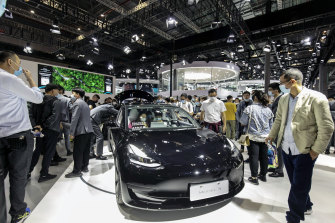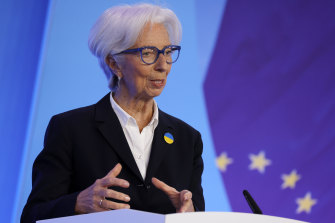

Tesla lost about a month of work during the Shanghai shutdown.Credit:Bloomberg
Relocating supply chains “might cost more, but if you can make smaller quantities that you can then sell at closer to full price, you can actually completely change the game,” said Brian Ehrig, a partner at the consulting firm Kearney and co-author of a report this month that found 78 per cent of CEOs are either considering reshoring or have done it already. Added Shay Luo, a Kearney principal who helped write the report: “My bet is that globalisation will never die, however, it will evolve to a different form.”
Companies have weathered the roughest bouts of supply turmoil over the past year partly by raising prices — and consumers have largely absorbed the hit. In the near term, though, supplies from China pose a more menacing cloud than the questions about household demand.
Tesla lost about a month of work during the Shanghai shutdown. Retailer Bed Bath & Beyond earlier this month said an “abnormally high” level of inventory was in transit, unavailable or held at ports through the early part of this quarter. Alcoa Corp, the aluminum giant that’s a bellwether for the global economy, last week blamed transport snarls for higher inventories. Continental AG, Europe’s second-largest maker of car parts, lowered its growth forecast for global production of passenger cars and light commercial vehicles to a range of 4 per cent to 6 per cent, from 6 per cent to 9 per cent previously.
Wang Xin, head of the Shenzhen Cross-Border E-Commerce Association, an organisation representing some 3000 exporters, said that even though a lockdown in that Chinese tech hub lasted only a week, “many sellers are suffering about a one-month delivery delay.”
It still takes an average of 111 days for goods to reach a warehouse in the US from the moment they’re ready to leave an Asian factory, close to the record of 113 set in January and more than double the trip in 2019, according to San Francisco-based Flexport Inc, a freight forwarder. The westbound journey to Europe takes even longer — a near-record 118 days.
Loading
Longer queues of vessels seen off China’s coast aren’t helping. The line of cargo carriers has jumped after Shanghai, home to the world’s largest container port, initiated a city-wide lockdown late last month to combat COVID-19 cases. The total number of container ships in port and off the hub’s shared anchorage with nearby Ningbo stood at 230 as of last Wednesday, a 35 per cent increase from this time last year, according to Bloomberg shipping data.
Imported containers are waiting on average for 12.1 days at Shanghai’s port before they are picked up by truck and delivered to destinations inland, according to supply-chain data provider project44. The rate for April 18 was almost triple the 4.6 days on March 28. Trucking shortages have crippled efforts to supply key inputs to factories and transport goods such as cars and electronics to the ships.
Air freight is also being affected, with deliveries into Shanghai Pudong International Airport backed up, Taipei-based air and ocean freight forwarder and logistics specialist Dimerco Express Corp said. That congestion has spread to Shenzhen, as the city that borders Hong Kong has seen a sharp increase in shipments rerouted from Shanghai.
To ease congestion around Shanghai, sailings are being diverted to Ningbo and Taicang, according to Donny Yang, Dimerco’s director of ocean freight. At the same time, the central government has instructed that highways be kept open and unobstructed.
Carmakers to electronics manufacturers in China’s financial hub have been gradually resuming operations, as authorities have encouraged the use of closed-loop systems, in which workers live on site at their factories.
“My guess is we’re going to see an enormous backlog of freight come out of there like a buckshot.”
Stephanie Loomis, vice president of international freight forwarder CargoTrans
Still, ramping up production from a shutdown isn’t an instant process. Tesla restarted its Shanghai factory after a three-week closure, though it’s uncertain how long the plant can operate with a limited supply of components.
“The change in COVID prevention policies in different cities has imposed an extraordinarily severe impact on logistics,” said Cui Dongshu, the secretary-general of the China Passenger Car Association.

Container ships docked at the Port of Oakland in California. Some of California’s backlog has merely shifted east in search of faster routes.Credit:David Paul Morris
Economists at Goldman Sachs Group, in a research note last week, said supply chain setbacks “have been somewhat worse than we anticipated, and we have adjusted our growth and inflation forecasts slightly in response in recent weeks.” When the bottlenecks in Asia start to clear, it will likely bring a flood of containers just as a seasonal pickup in imports gets underway.
“Some companies may have already tried to ship their orders somewhere else or they cancelled them,” said Stephanie Loomis, vice president of international procurement at freight forwarder CargoTrans. “But my guess is we’re going to see an enormous backlog of freight come out of there like a buckshot.”
The total container-ship count for America’s dual hub of Los Angeles and Long Beach reached at least 57 vessels last Wednesday, the highest since late February. A few other gauges like container dwell times are also creeping higher again.
Some of California’s backlog has merely shifted east in search of faster routes — shiploads of goods are lined up from New York City to Charleston, South Carolina. Data from MarineTraffic recently showed a major reversal: The US East Coast topped the West Coast in the amount of container capacity that’s waiting at anchor to offload.
The pile-ups in Europe are just as severe or worse, compounded by the proximity to the war in Ukraine. Key ports such as Rotterdam, Hamburg, Antwerp and three in the UK are working at or above capacity, which means they’re already struggling to accept more containers because they don’t have space to store them.

European Central Bank president Christine Lagarde.Credit:Getty
European Central Bank President Christine Lagarde, in a speech Friday, said Europe’s integration in global value chains was even deeper than the US’s. Trade as a share of the euro area’s gross domestic product rose to 54 per cent in 2019 from 31 per cent two decades earlier, she said, compared with America’s 3 percentage-point rise to 26 per cent.
She also cited a recent survey that found 46 per cent of German companies get significant inputs from China. Of those, almost half are planning to reduce that dependency. Russia’s invasion now means the search for the lowest-cost suppliers must be refocused around geopolitical alliances.
“We must work towards making trade safer in these unpredictable times, while also leveraging our regional strength,” said Lagarde, the former managing director of the International Monetary Fund. “Even industries that are not considered strategic are likely to anticipate the fracturing of the global trading order and adjust production themselves.”









 Add Category
Add Category